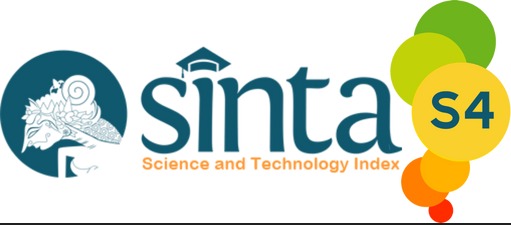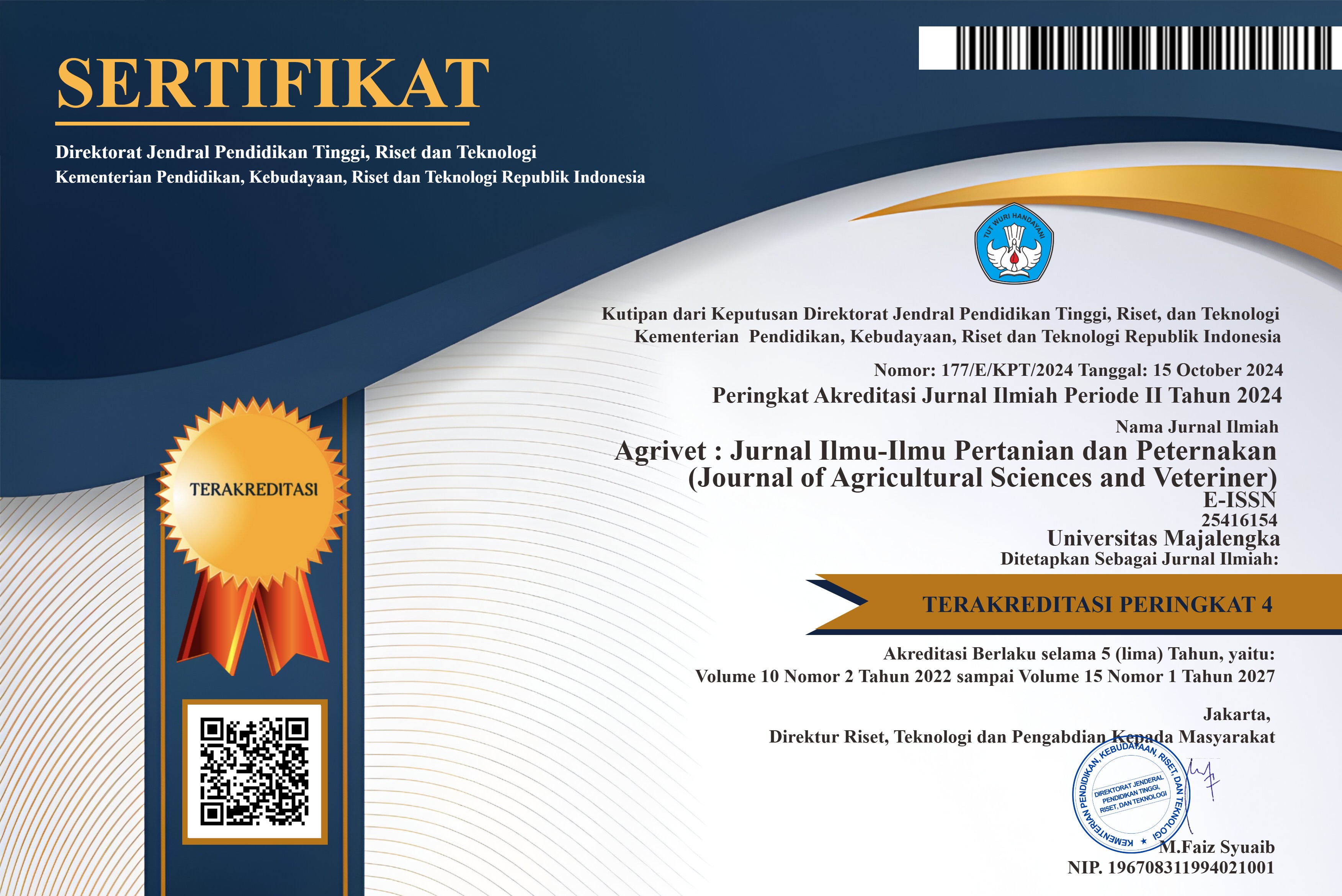Studi pertumbuhan dan evaluasi parameter tumpangsari kubis bunga (Brassica oleracea L.) dengan tanaman legum
DOI:
https://doi.org/10.31949/agrivet.v12i1.9665Abstract
This research aims to determine the growth and evaluate the parameters of Cauliflower (Brassica oleracea L.) planted with several legume plants at different levels of plant density. The research was conducted in Telukjambe Village, East Telukjambe District, Karawang Regency in December 2022 – March 2023. The research used an experimental method with a single-factor Randomized Group Design (RAK) with 3 sets of experimental designs, each consisting of 5 proportion treatments. inter-cropping and repeat 5 times. The treatment given is; K1= 100% cauliflower , K2= 25% cauliflower + 75% legumes, K3= 50% cauliflower + 50% legumes, K4 = 75% cauliflower + 25% legumes, K5= 100% legumes. The first set of experimental designs is a system of inter-cropping cauliflower with soybeans, the second experimental set is a system of inter-cropping cauliflower with peanuts and the third experimental set is a system of inter-cropping cauliflower with green beans. The research results were analyzed using the F test at a level of 5% and a Least Significant Difference (BNT) further test at a level of 5%. The results showed that inter-cropping of cauliflower and soybeans (experimental set 1) provided beneficial results compared to inter-cropping with peanuts and green beans. The results can be seen from the LER and RCC values for all proportions of planting number or plant population density levels > 1. The highest LER and RCC values for inter-cropping cauliflower and soybeans (experimental set 1) were shown in the K3 treatment (50% Cauliflower + 50% Soybeans) namely 1.49 and 10.8.
Keywords:
Inter-cropping, cauliflower, legumes, parameter evaluationDownloads
References
Ariana Rusbiyati, Rohlan Rogomulyo, dan Sri Muhartini. (2018). Pengaruh Proporsi Tanaman terhadap Pertumbuhan dan Hasil Tumpangsari Kubis (Brassica oleracea Var. Capitata L.) dengan Tomat (Lycopersicum esculentum Mill.). Vegetalika, 7(4); 26-38.
Ceunfin, Syprianus, Djoko Prajitno, Priyono Suryanto dan Eka Tarwaca Susila Putra. (2017). Penilaian Kompetisi dan Keuntungan Hasil Tumpangsari Jagung Kedelai di Bawah Tegakan Kayu Putih. Jurnal Pertanian Konservasi Lahan Kering. 2(1) : 1-3.
Chavda, M. H., Patel, K. M. and Vala, Y. B. (2023). Assessment of Intercropping Indices of Mustard (Brassica juncea L.) With Chickpea and Field Pea Ratio. The Pharma Innovation Journal, 12 (2) : 2837-2841.
Gebru, H., (2015). A Review on The Comparative Advantages of Intercropping to Monocropping System. Journal of Biology, Agriculture and Healthcare, 9 (5) : 1-13.
Gendy Ahmed S., Walid and Dalia. (2017). Evaluation of Competitive Indices Between Roselle and Cowpea as Influenced By Intercropping System and Bio-Fertilization Type. Middle East Journal of Agriculture Research, 6 (1) : 199-207.
Hasan, William Briggs, Claudia Matschegewski dan Frank Ordon. (2016). Quantitative Trait Loci Controlling Leaf Appearance and Curd Initiation of Cauliflower in Relation to Temperature. Theor. Appl. Genet, 129 (1) :1273-1288.
Herlina, Ninuk D. (2018). Pengaruh Jarak Tanam Jagung Manis dan Varietas Kedelai terhadap Pertumbuhan dan Hasil Kedua Tanaman dalam Sistem Tanam Tumpangsari. Buletin Palawija,16(1); 9-16.
Iqball Muhammad , Hamid, A. and Ahmad, T. (2019). Forage Sorghum Legumes Intercropping : Effect Growth, Yields, Nutritional Quality and Economic Returns. Institudo Agronomico de Campinas, 78 (1) : 1-15.
Karunarathna B, Maduwanthi. (2022). Competition Indices Used to Evaluate The Agronomic and Monetary Advantage in Intercropping: A Review. AGRIEAST, 16 (1) : 25-40.
Layek, Anup, D. and Mitran, T. (2018). Cereal + Legume Intercropping: An Option For Improving Productivity and Sustaining Soil Health. Legumes For Soil Health and Sustainable Management, 8 (1) : 347-386.
Marliah Ainun, Hidayat, T. dan Husna, N. (2013). Pengaruh Varietas dan Jarak Tanam terhadap Pertumbuhan Kedelai (Glycine Max (L.) Merrill). Jurnal Agrista, 16 (1) : 22-28.
Marlina L, Muharam. M dan Yayu Sri Rahayu. (2021). Pengaruh Jarak Tanam dan Macam Varietas terhadap Pertumbuhan dan Hasil Kubis Bunga (Brassica oleracea var botrytis L.) di Lahan Sawah Tadah Hujan. Jurnal Ilmiah Wahana Pendidikan, 7 (7) ; 371-378.
Munawar. 2011. Kesuburan Tanah dan Nutrisi Tanaman. IPB Press.
Rana, M. M., Buhiya, M. S. U. and Akhmad, M. I. M. (2013). Effect of Intercropping of Sesbania Rostrata With Transplant a Man Rice on Yield and Profitability. IOSR J. Agri. Veter. Sci, 2 (1) : 10-14.
Rofiah, D. P. S. S. B. (2018). Pengaruh Saat Tanam Jagung Manis Hibrida (Zea mays L.) Terhadap Pertumbuhan dan Hasil Kubis Bunga (Brassica oleracea var. botrytis, L.) Dataran Rendah Dalam Sistem Tumapangsari. Jurnal Agroteknologi Merdeka Pasuruan, 2 (1), 16-21.
Rusbiyanti Ariana, Rohlan Rogomulyo dan Sri Muhartini. (2018). Pengaruh Proporsi Tanaman terhadap Pertumbuhan dan Hasil Tumpangsari Kubis (Brassica oleracea Var. Capitata L.) dengan Tomat (Lycopersicum esculentum Mill.). Vegetalika, 7 (4) : 26-38.
Suryanto, A. (2019). Pola Tanam. Universitas Brawijaya Press.
Trisnaningsih Umi, Siti Wahyuni dan Meilina Prasetyo. (2020). Pertumbuhan dan Hasil Tiga Kultivar Kacang Hijau pada Jarak Tanam yang Berbeda. J. Agrotek Tropika, 8 (1) : 145-155.
Published
How to Cite
Issue
Section
License
Copyright (c) 2024 Devie Rienzani Supriadi, Ekalia Yusiana

This work is licensed under a Creative Commons Attribution-ShareAlike 4.0 International License.
An author who publishes in the Jurnal Agrivet agrees to the following terms:
- Author retains the copyright and grants the journal the right of first publication of the work simultaneously licensed under the Creative Commons Attribution-ShareAlike 4.0 License that allows others to share the work with an acknowledgment of the work's authorship and initial publication in this journal
- The author is able to enter into separate, additional contractual arrangements for the non-exclusive distribution of the journal's published version of the work (e.g., post it to an institutional repository or publish it in a book) with the acknowledgment of its initial publication in this journal.
- The author is permitted and encouraged to post his/her work online (e.g., in institutional repositories or on their website) prior to and during the submission process, as it can lead to productive exchanges, as well as earlier and greater citation of the published work









